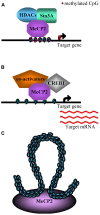MeCP2 as a genome-wide modulator: the renewal of an old story
- PMID: 22973303
- PMCID: PMC3438687
- DOI: 10.3389/fgene.2012.00181
MeCP2 as a genome-wide modulator: the renewal of an old story
Abstract
Since the discovery of MeCP2, its functions have attracted the interest of generations of molecular biologists. Its function as a transducer of DNA methylation, the major post-biosynthetic modification found throughout genomes, and its association with the neurodevelopmental disease Rett syndrome highlight its central role as a transcriptional regulator, and, at the same time, poses puzzling questions concerning its roles in physiology and pathology. The classical model of the MeCP2 function predicts its role in gene-specific repression through the binding of methylated DNA, via its interaction with the histone deacetylases and co-repressor complexes. This view has been questioned and, intriguingly, new roles for MeCP2 as a splicing modulator and as a transcriptional activator have been proposed. Recent data have demonstrated that MeCP2 is extremely abundant in the neurons, where it reaches the level of histone H1; it is widely distributed, tracking the methylated CpGs, and regulates repetitive elements expression. The role of MeCP2 in maintaining the global chromatin structure is further sustained by its involvement in other biologically relevant phenomena, such as the Line-1 repetitive sequences retrotransposition and the pericentromeric heterochromatin clustering during cellular differentiation. These new concepts renew the old view suggesting a role for DNA methylation in transcriptional noise reduction, pointing to a key role for MeCP2 in the modulation of the genome architecture.
Keywords: DNA methylation; MECP2; Rett syndrome; chromatin; epigenetics.
Figures


Similar articles
-
MECP2, a multi-talented modulator of chromatin architecture.Brief Funct Genomics. 2016 Nov;15(6):420-431. doi: 10.1093/bfgp/elw023. Epub 2016 Jun 12. Brief Funct Genomics. 2016. PMID: 27296483 Review.
-
Rett syndrome: a surprising result of mutation in MECP2.Hum Mol Genet. 2000 Oct;9(16):2365-75. doi: 10.1093/hmg/9.16.2365. Hum Mol Genet. 2000. PMID: 11005791 Review.
-
Genomic insights into MeCP2 function: A role for the maintenance of chromatin architecture.Curr Opin Neurobiol. 2019 Dec;59:174-179. doi: 10.1016/j.conb.2019.07.002. Epub 2019 Aug 17. Curr Opin Neurobiol. 2019. PMID: 31430649 Free PMC article. Review.
-
MeCP2 heterochromatin organization is modulated by arginine methylation and serine phosphorylation.Front Cell Dev Biol. 2022 Sep 12;10:941493. doi: 10.3389/fcell.2022.941493. eCollection 2022. Front Cell Dev Biol. 2022. PMID: 36172281 Free PMC article.
-
The biological functions of the methyl-CpG-binding protein MeCP2 and its implication in Rett syndrome.Brain Dev. 2001 Dec;23 Suppl 1:S32-7. doi: 10.1016/s0387-7604(01)00333-3. Brain Dev. 2001. PMID: 11738839 Review.
Cited by
-
Epigenetic Factors That Control Pericentric Heterochromatin Organization in Mammals.Genes (Basel). 2020 May 28;11(6):595. doi: 10.3390/genes11060595. Genes (Basel). 2020. PMID: 32481609 Free PMC article. Review.
-
From adjacent activation in Escherichia coli and DNA cyclization to eukaryotic enhancers: the elements of a puzzle.Front Genet. 2014 Nov 3;5:371. doi: 10.3389/fgene.2014.00371. eCollection 2014. Front Genet. 2014. PMID: 25404937 Free PMC article.
-
Rett syndrome and MeCP2.Neuromolecular Med. 2014 Jun;16(2):231-64. doi: 10.1007/s12017-014-8295-9. Epub 2014 Mar 11. Neuromolecular Med. 2014. PMID: 24615633 Free PMC article. Review.
-
Transcriptomic and Epigenomic Landscape in Rett Syndrome.Biomolecules. 2021 Jun 30;11(7):967. doi: 10.3390/biom11070967. Biomolecules. 2021. PMID: 34209228 Free PMC article. Review.
-
Merging data from genetic and epigenetic approaches to better understand autistic spectrum disorder.Epigenomics. 2016 Jan;8(1):85-104. doi: 10.2217/epi.15.92. Epub 2015 Nov 9. Epigenomics. 2016. PMID: 26551091 Free PMC article.
References
-
- Agarwal N., Becker A., Jost K. L., Haase S., Thakur B. K., Brero A., Hardt T., Kudo S., Leonhardt H., Cardoso M. C. (2011). MeCP2 Rett mutations affect large scale chromatin organization. Hum. Mol. Genet. 20 4187–4195 - PubMed
-
- Amir R. E., Van den Veyver I. B., Wan M., Tran C. Q., Francke U., Zoghbi H. Y. (1999). Rett syndrome is caused by mutations in X-linked MECP2, encoding methyl-CpG-binding protein 2. Nat. Genet. 23 185–188 - PubMed
LinkOut - more resources
Full Text Sources

